Annual Demographic Estimates: Subprovincial Areas, July 1, 2016
Section 1: Census metropolitan areas
Archived Content
Information identified as archived is provided for reference, research or recordkeeping purposes. It is not subject to the Government of Canada Web Standards and has not been altered or updated since it was archived. Please "contact us" to request a format other than those available.
On July 1, 2016, 25,534,700 people were living in a census metropolitan area (CMA). The proportion of the population living in a CMA continued to increase to 70.4%, or 7 in 10 Canadians. Canada’s three largest CMAs alone—Toronto, Montréal and Vancouver—were home to more than one in three Canadians (35.5%).
Between July 1, 2015 and June 30, 2016 (the 2015/2016 period), population growth was much higher in CMAs (+15.9 per thousand) than in non-CMAs (+3.3 per thousand). The five CMAs with the highest population growth were in the Prairies. As well, for the fifth consecutive year, the three CMAs with the highest growth were in Alberta and Saskatchewan.
The overall growth of CMAs in the most recent annual period (+15.9 per thousand) exceeded the growth in 2014/2015 (+11.1 per thousand), similar to the trend observed for Canada as a whole.Note 1 Preliminary estimates show that of all the CMAs in Canada, Saskatoon had the greatest population growth in 2015/2016 (+31.1 per thousand). The population of two CMAs decreased in the most recent period: Thunder Bay (-2.5 per thousand) and Saguenay (-2.0 per thousand).
Start of text boxFor the rest of this analysis, a rate higher than -1 per thousand and lower than 1 per thousand is considered to be nil or low. Rates are based on the ratio of the number of events during the period (t, t+x) to the average of the populations at the beginning and end of the period. Five-year rates are annualized. Preliminary postcensal estimates are subject to revision. Future updates could affect trend analysis.
CMA growth unequal from east to west
In the Atlantic provinces, Halifax (+19.3 per thousand) was the only CMA whose population growth was higher than the growth of all CMAs combined (+15.9 per thousand). Moreover, the population growth of the Saint John CMA, although positive for the first time since 2010/2011, was relatively moderate (+4.5 per thousand).
In Quebec, the population growth of each of the six CMAs was lower than that of all the CMAs combined. The population of the Saguenay CMA decreased (-2.0 per thousand) for a third consecutive year.
In Ontario, Toronto (+19.1 per thousand), the Ontario part of Ottawa–Gatineau (+17.5 per thousand) and Guelph (+16.1 per thousand) were the only three of the province’s 15 CMAs whose population growth was higher than the growth of all CMAs combined. The population of the Thunder Bay CMA decreased (-2.5 per thousand) for a third consecutive year, while the population of the Greater Sudbury CMA remained relatively stable (+0.1 per thousand) after edging down over the previous two years.
Similar to the demographic trends observed in the provinces, the CMAs in the Prairies stood out on account of their strong population growth. The two CMAs in Saskatchewan, Saskatoon (+31.1 per thousand) and Regina (+26.0 per thousand), had the highest population growth in 2015/2016. They were followed by the Alberta CMAs of Calgary (+24.6 per thousand) and Edmonton (+24.3 per thousand). However, the population growth of CMAs in Alberta varied little between 2014/2015 and 2015/2016, unlike that of all the CMAs, which was up 43.0% over the same period.
In British Columbia, only the Vancouver CMA (+16.3 per thousand) posted population growth higher than the growth of all CMAs combined.
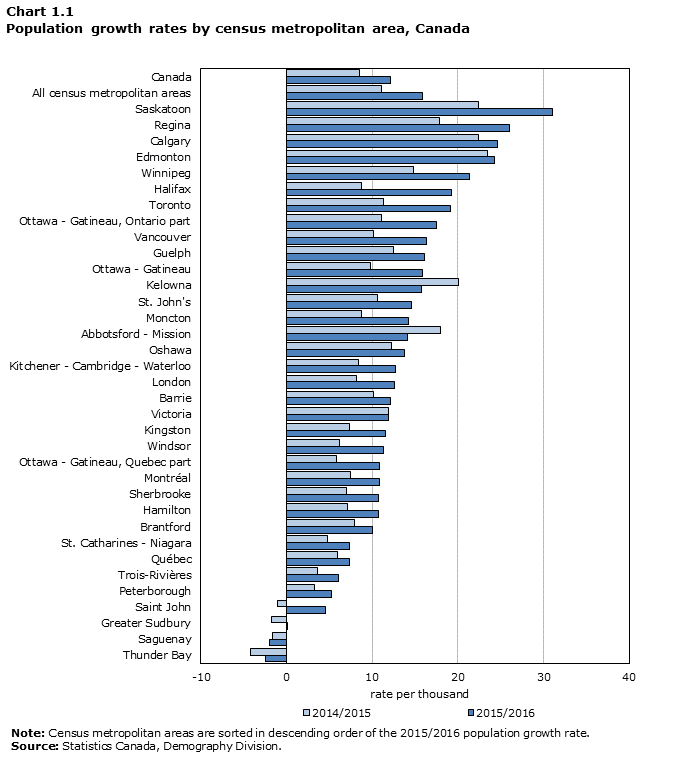
Data table for Chart 1.1
| Census metropolitan areas | 2014/2015 | 2015/2016 |
|---|---|---|
| rate per thousand | ||
| Thunder Bay | -4.2 | -2.5 |
| Saguenay | -1.6 | -2.0 |
| Greater Sudbury | -1.7 | 0.1 |
| Saint John | -1.1 | 4.5 |
| Peterborough | 3.3 | 5.2 |
| Trois-Rivières | 3.6 | 6.1 |
| Québec | 6.0 | 7.4 |
| St. Catharines - Niagara | 4.8 | 7.4 |
| Brantford | 7.9 | 10.0 |
| Hamilton | 7.1 | 10.7 |
| Sherbrooke | 7.0 | 10.7 |
| Montréal | 7.5 | 10.8 |
| Ottawa - Gatineau, Quebec part | 5.8 | 10.9 |
| Windsor | 6.2 | 11.3 |
| Kingston | 7.4 | 11.5 |
| Victoria | 11.9 | 11.9 |
| Barrie | 10.2 | 12.1 |
| London | 8.2 | 12.6 |
| Kitchener - Cambridge - Waterloo | 8.4 | 12.7 |
| Oshawa | 12.3 | 13.8 |
| Abbotsford - Mission | 18.0 | 14.1 |
| Moncton | 8.7 | 14.2 |
| St. John's | 10.6 | 14.6 |
| Kelowna | 20.1 | 15.8 |
| Ottawa - Gatineau | 9.8 | 15.9 |
| Guelph | 12.5 | 16.1 |
| Vancouver | 10.2 | 16.3 |
| Ottawa - Gatineau, Ontario part | 11.1 | 17.5 |
| Toronto | 11.3 | 19.1 |
| Halifax | 8.8 | 19.3 |
| Winnipeg | 14.8 | 21.3 |
| Edmonton | 23.5 | 24.3 |
| Calgary | 22.4 | 24.6 |
| Regina | 17.8 | 26.0 |
| Saskatoon | 22.4 | 31.1 |
| All census metropolitan areas | 11.1 | 15.9 |
| Canada | 8.5 | 12.1 |
|
Note: Census metropolitan areas are sorted in descending order of the 2015/2016 population growth rate. Source: Statistics Canada, Demography Division. |
||
Population growth of CMAs stimulated by immigration
Similar to provincial population growth, the population growth of CMAs in 2015/2016 was driven significantly by immigration, in part due to the arrival of Syrian refugees.Note 2 For example, in each of the 10 CMAs with the highest population growth, international migration was the main source of growth. Several CMAs received a record number of immigrants over the last year, particularly each of the five CMAs in the Prairies and each of the four CMAs in the Atlantic provinces. Canada’s three largest CMAs continued to be the main destination for new immigrants, even though those CMAs did not receive a record number of immigrants in 2015/2016.
Net interprovincial migration was the main factor in the population growth of only two CMAs, Kelowna (+2,800) and Victoria (+3,400), British Columbia. In Alberta, the Calgary CMA recorded interprovincial migration losses (-900) for the first time since 2009/2010, while gains in Edmonton (+2,400) were considerably smaller than in the previous four years (+11,300 on average). Conversely, the Toronto CMA had positive net interprovincial migration (+4,100) for the first time since 2010/2011. These trends reflect existing provincial findings for 2015/2016, which showed interprovincial migration gains in British Columbia and in Ontario, but losses in Alberta.
Intraprovincial migration was largely responsible for population growth in seven CMAs with populations under 500,000 (Trois-Rivières, Kingston, Peterborough, Oshawa, St. Catharines–Niagara, Brantford and Barrie). Many of these smaller CMAs are near the Toronto CMA, and their migratory gains were mainly at the expense of Toronto.
Population decreases in two CMAs and in non-CMAs in several eastern and central Canadian provinces
Although Canada’s overall population grew, as did the populations of most CMAs, some regions nevertheless saw their populations decrease.
For a third consecutive year, the Thunder Bay and Saguenay CMAs each recorded a population decrease of 300 in 2015/2016. In Thunder Bay, net international migration (+100) was not enough to offset the net losses due to natural increase (-200) and internal migration (-200). In Saguenay, despite positive natural increase (+300), the CMA’s population declined due to intraprovincial migration losses (-600).
In non-CMAs, population decreases were observed in Newfoundland and Labrador (-1,700), Nova Scotia (-2,000), and New Brunswick (-200). These population decreases were due to a combination of factors, including interprovincial migration, negative intraprovincial migration and more deaths than births.
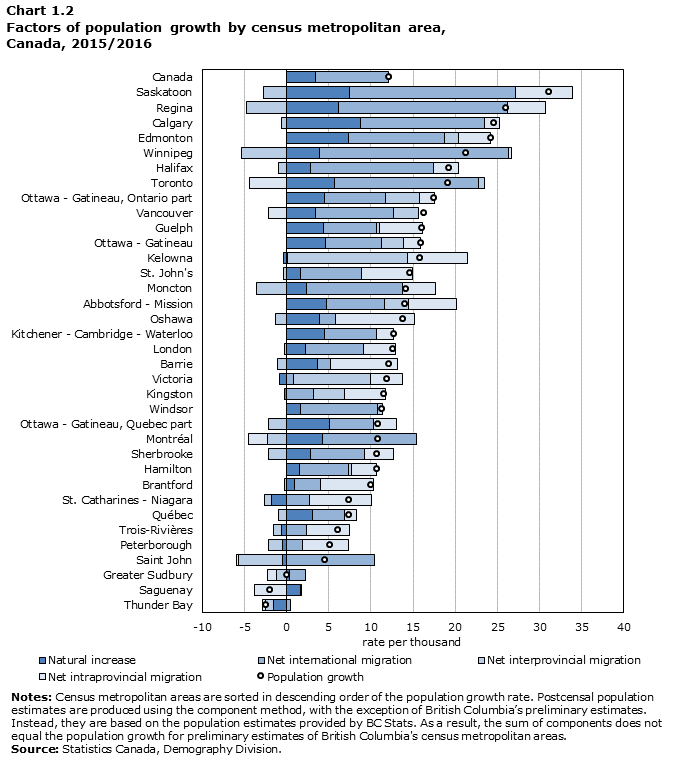
Data table for Chart 1.2
| Census metropolitan areas | Natural increase | Net international migration | Net interprovincial migration | Net intraprovincial migration | Population growth |
|---|---|---|---|---|---|
| rate per thousand | |||||
| Thunder Bay | -1.6 | 0.5 | -0.9 | -0.4 | -2.5 |
| Saguenay | 1.6 | 0.0 | 0.2 | -3.8 | -2.0 |
| Greater Sudbury | 0.3 | 1.9 | -1.2 | -1.1 | 0.1 |
| Saint John | -0.5 | 10.4 | -5.2 | -0.2 | 4.5 |
| Peterborough | -0.5 | 1.9 | -1.6 | 5.5 | 5.2 |
| Trois-Rivières | -0.6 | 2.4 | -0.9 | 5.1 | 6.1 |
| Québec | 3.1 | 3.8 | -1.0 | 1.4 | 7.4 |
| St. Catharines - Niagara | -1.8 | 2.7 | -0.8 | 7.4 | 7.4 |
| Brantford | 0.9 | 3.1 | -0.3 | 6.3 | 10.0 |
| Hamilton | 1.5 | 5.9 | 0.3 | 3.0 | 10.7 |
| Sherbrooke | 2.8 | 6.5 | -2.1 | 3.4 | 10.7 |
| Montréal | 4.2 | 11.2 | -2.3 | -2.2 | 10.8 |
| Ottawa - Gatineau, Quebec part | 5.1 | 5.2 | -2.1 | 2.7 | 10.9 |
| Windsor | 1.7 | 9.1 | 0.6 | 0.0 | 11.3 |
| Kingston | -0.2 | 3.2 | 3.7 | 4.8 | 11.5 |
| Victoria | -0.9 | 0.8 | 9.1 | 3.9 | 11.9 |
| Barrie | 3.7 | 1.5 | -1.1 | 7.9 | 12.1 |
| London | 2.3 | 6.8 | -0.3 | 3.8 | 12.6 |
| Kitchener - Cambridge - Waterloo | 4.5 | 6.2 | 0.0 | 2.0 | 12.7 |
| Oshawa | 3.9 | 1.9 | -1.3 | 9.4 | 13.8 |
| Abbotsford - Mission | 4.7 | 6.9 | 2.9 | 5.7 | 14.1 |
| Moncton | 2.4 | 11.3 | -3.6 | 4.0 | 14.2 |
| St. John's | 1.6 | 7.3 | -0.4 | 6.0 | 14.6 |
| Kelowna | -0.4 | 0.1 | 14.3 | 7.1 | 15.8 |
| Ottawa - Gatineau | 4.6 | 6.7 | 2.6 | 2.0 | 15.9 |
| Guelph | 4.4 | 6.3 | 0.3 | 5.1 | 16.1 |
| Vancouver | 3.4 | 9.3 | 2.9 | -2.2 | 16.3 |
| Ottawa - Gatineau, Ontario part | 4.5 | 7.2 | 4.1 | 1.7 | 17.5 |
| Toronto | 5.7 | 17.1 | 0.7 | -4.4 | 19.1 |
| Halifax | 2.8 | 14.6 | -1.0 | 3.0 | 19.3 |
| Winnipeg | 3.9 | 22.4 | -5.3 | 0.4 | 21.3 |
| Edmonton | 7.4 | 11.3 | 1.7 | 3.8 | 24.3 |
| Calgary | 8.8 | 14.7 | -0.6 | 1.8 | 24.6 |
| Regina | 6.1 | 20.1 | -4.7 | 4.5 | 26.0 |
| Saskatoon | 7.5 | 19.6 | -2.7 | 6.8 | 31.1 |
| Canada | 3.4 | 8.7 | 0.0 | 0.0 | 12.1 |
|
Notes: Census metropolitan areas are sorted in descending order of the population growth rate. Postcensal population estimates are produced using the component method, with the exception of British Columbia’s preliminary estimates. Instead, they are based on the population estimates provided by BC Stats. As a result, the sum of components does not equal the population growth for preliminary estimates of British Columbia's census metropolitan areas. Source: Statistics Canada, Demography Division. |
|||||
Toronto posts highest population growth of Canada’s three largest CMAs
Canada’s three largest CMAs had a total combined population of 12.9 million on July 1, 2016, or more than one in three Canadians (35.5%).
Of Canada’s three largest CMAs, Toronto had the strongest population growth in 2015/2016. With an increase of 118,300 people (+19.1 per thousand), the population of Canada’s largest CMA was 6,242,300. A growth rate that high had not been recorded in the Toronto CMA since 2001/2002 (+24.5 per thousand). It occurred after a period of more moderate growth, while the lowest population growth rate since 1990/1991 was recorded last year (+11.3 per thousand). Increased international migration was largely the reason that population growth resumed in the Toronto CMA. In the Montréal CMA in 2015/2016, the population grew by 44,100 people (+10.8 per thousand) to 4,093,800. Lastly, the population of the Vancouver CMA was 2,548,700 on July 1, 2016, up 41,300 (+16.3 per thousand) from the previous year.
In each of Canada’s three major CMAs, international migration was the main driver of population growth. However, the proportion of immigrants who settled in one of the three largest CMAs continues to decline. In 2015/2016, 53.8% of immigrants who settled in Canada (172,700) chose to live in the Toronto, Montréal or Vancouver CMA, compared with 71.7% 10 years ago, in 2005/2006. This decrease primarily benefited the five Prairie CMAs (Winnipeg, Saskatoon, Regina, Calgary and Edmonton), which received an increased proportion of immigrants in 2015/2016 (23.0%) compared with 2005/2006 (9.8%).
Lastly, the three largest CMAs in Canada saw migration losses within the rest of their province, specifically Toronto (-26,900), Montréal (-9,100) and Vancouver (-5,600). These intraprovincial migration losses mainly benefited outlying CMAs or neighbouring non-CMA areas. In particular, the Toronto CMA recorded migration losses to the benefit of the neighbouring CMAs of Oshawa, Hamilton and Barrie. The migration losses were the most pronounced among persons aged 30 to 64 years and children under 18 years of age.
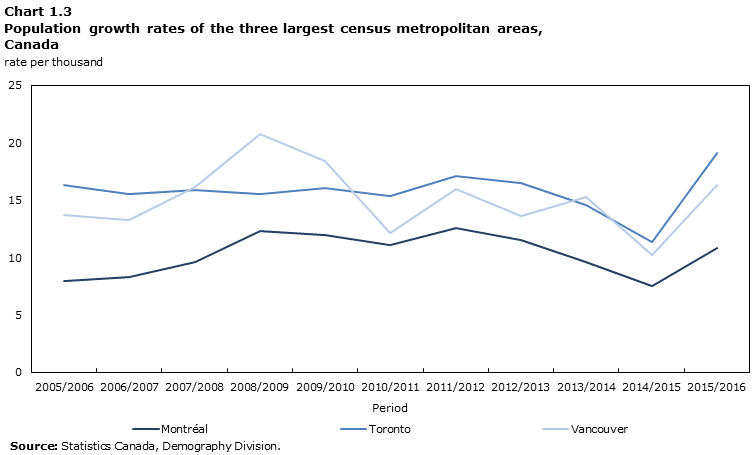
Data table for Chart 1.3
| Census metropolitan areas | 2005/2006 | 2006/2007 | 2007/2008 | 2008/2009 | 2009/2010 | 2010/2011 | 2011/2012 | 2012/2013 | 2013/2014 | 2014/2015 | 2015/2016 |
|---|---|---|---|---|---|---|---|---|---|---|---|
| period | |||||||||||
| Montréal | 7.9 | 8.3 | 9.6 | 12.3 | 12.0 | 11.1 | 12.6 | 11.5 | 9.6 | 7.5 | 10.8 |
| Toronto | 16.3 | 15.5 | 15.9 | 15.6 | 16.1 | 15.4 | 17.1 | 16.5 | 14.6 | 11.3 | 19.1 |
| Vancouver | 13.7 | 13.3 | 16.2 | 20.7 | 18.4 | 12.2 | 16.0 | 13.6 | 15.3 | 10.2 | 16.3 |
| Source: Statistics Canada, Demography Division. | |||||||||||
Start of text box
For the purposes of this article, various indicators will be used to measure the aging of a population. The distribution of the population aged 0 to 14 years and 65 years and over and the median age will be the indicators considered. The median age is an age “x” that divides the population into two equal groups, such that one contains only those individuals older than “x” and the other those younger than “x.”
Population of CMAs younger than in the rest of Canada
On July 1, 2016, the median age of the population residing in a CMA was 39.3 years. By comparison, the median age of the non-CMA population was higher, at 44.1 years.
The age structure of CMA and non-CMA populations differs mainly in terms of the demographic weight of the age groups starting at 15 years, as the age pyramid in Figure 1.1 shows. On one hand, the group of persons aged 65 and older accounted for 19.6% of the non-CMA population, compared with 15.2% of those in CMAs. On the other hand, Figure 1.1 shows that persons aged 20 to 49 years represented a larger portion of the population of CMAs than of non-CMAs. This is the result of young adults migrating from non-CMAs to CMAs, as well as a greater influx of immigrants into CMAs—nearly two thirds of the immigrants who settled in a CMA were aged 20 to 49 years.
Although the number of persons aged 65 years and older exceeded the number of children aged 0 to 14 years in Canada in 2014/2015, 14 CMAs still had more children than seniors on July 1, 2016.
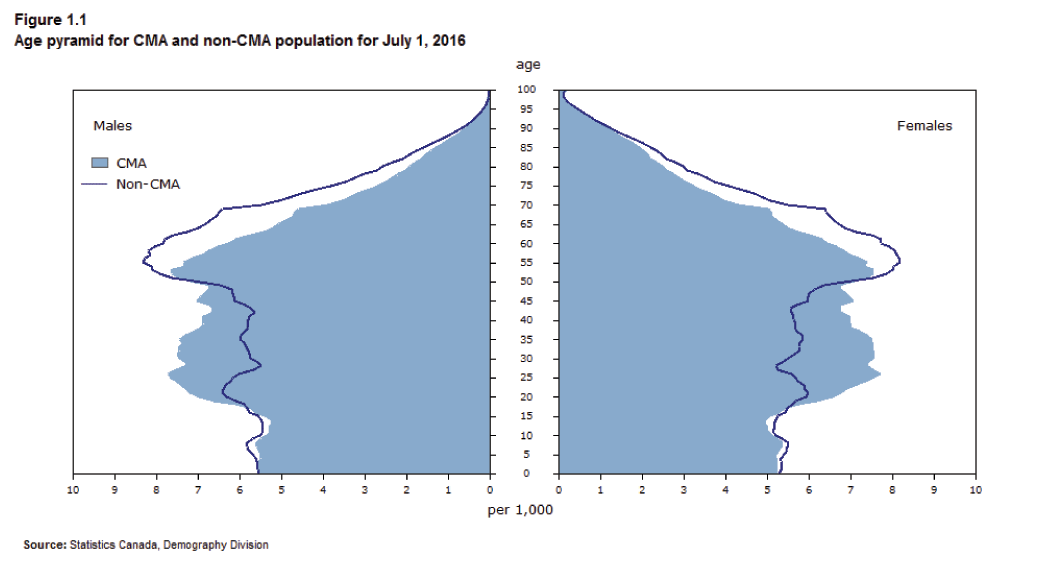
Description for Figure 1.1
This stacked column graph or age pyramid compares the age structure of the CMA and the non-CMA population for July 1, 2016 in relative value.
The left side shows males and the right side shows females.
The horizontal axis shows the population in relative value and the vertical axis shows age.
| Age | Non-CMA | CMA | ||
|---|---|---|---|---|
| Males | Females | Males | Females | |
| per thousand | ||||
| 0 | 5.5 | 5.3 | 5.5 | 5.2 |
| 1 | 5.6 | 5.3 | 5.5 | 5.2 |
| 2 | 5.6 | 5.4 | 5.5 | 5.2 |
| 3 | 5.6 | 5.3 | 5.5 | 5.2 |
| 4 | 5.6 | 5.3 | 5.5 | 5.2 |
| 5 | 5.7 | 5.4 | 5.5 | 5.2 |
| 6 | 5.8 | 5.5 | 5.5 | 5.3 |
| 7 | 5.8 | 5.5 | 5.6 | 5.3 |
| 8 | 5.8 | 5.5 | 5.6 | 5.4 |
| 9 | 5.7 | 5.4 | 5.5 | 5.2 |
| 10 | 5.5 | 5.2 | 5.3 | 5.1 |
| 11 | 5.4 | 5.1 | 5.3 | 5.0 |
| 12 | 5.5 | 5.2 | 5.3 | 5.0 |
| 13 | 5.4 | 5.2 | 5.2 | 4.9 |
| 14 | 5.5 | 5.2 | 5.2 | 5.0 |
| 15 | 5.6 | 5.3 | 5.4 | 5.1 |
| 16 | 5.8 | 5.4 | 5.6 | 5.3 |
| 17 | 5.8 | 5.5 | 5.7 | 5.4 |
| 18 | 5.9 | 5.6 | 6.1 | 5.8 |
| 19 | 6.1 | 5.7 | 6.6 | 6.2 |
| 20 | 6.3 | 5.9 | 7.0 | 6.6 |
| 21 | 6.4 | 6.0 | 7.2 | 6.8 |
| 22 | 6.4 | 5.9 | 7.3 | 6.9 |
| 23 | 6.3 | 5.9 | 7.4 | 7.1 |
| 24 | 6.2 | 5.7 | 7.5 | 7.4 |
| 25 | 6.2 | 5.7 | 7.6 | 7.5 |
| 26 | 6.0 | 5.6 | 7.7 | 7.7 |
| 27 | 5.7 | 5.3 | 7.5 | 7.5 |
| 28 | 5.5 | 5.2 | 7.3 | 7.4 |
| 29 | 5.6 | 5.4 | 7.3 | 7.4 |
| 30 | 5.7 | 5.5 | 7.4 | 7.5 |
| 31 | 5.8 | 5.7 | 7.5 | 7.6 |
| 32 | 5.8 | 5.8 | 7.4 | 7.5 |
| 33 | 5.8 | 5.8 | 7.4 | 7.5 |
| 34 | 5.9 | 5.8 | 7.4 | 7.5 |
| 35 | 6.0 | 5.9 | 7.4 | 7.5 |
| 36 | 6.0 | 5.8 | 7.3 | 7.4 |
| 37 | 5.9 | 5.7 | 7.1 | 7.2 |
| 38 | 5.8 | 5.7 | 6.9 | 7.0 |
| 39 | 5.8 | 5.7 | 6.9 | 7.0 |
| 40 | 5.8 | 5.6 | 6.9 | 7.0 |
| 41 | 5.8 | 5.6 | 6.9 | 7.0 |
| 42 | 5.6 | 5.6 | 6.6 | 6.8 |
| 43 | 5.7 | 5.6 | 6.6 | 6.7 |
| 44 | 5.9 | 5.7 | 6.7 | 6.8 |
| 45 | 6.1 | 6.0 | 7.0 | 7.1 |
| 46 | 6.1 | 6.0 | 6.9 | 7.0 |
| 47 | 6.2 | 6.0 | 6.8 | 6.9 |
| 48 | 6.2 | 6.1 | 6.7 | 6.8 |
| 49 | 6.5 | 6.4 | 6.7 | 6.7 |
| 50 | 6.9 | 6.8 | 7.1 | 7.0 |
| 51 | 7.6 | 7.5 | 7.4 | 7.4 |
| 52 | 7.9 | 7.9 | 7.6 | 7.5 |
| 53 | 8.1 | 8.0 | 7.6 | 7.5 |
| 54 | 8.1 | 8.0 | 7.3 | 7.3 |
| 55 | 8.3 | 8.2 | 7.3 | 7.4 |
| 56 | 8.3 | 8.2 | 7.1 | 7.2 |
| 57 | 8.1 | 8.1 | 6.9 | 7.0 |
| 58 | 8.2 | 8.1 | 6.7 | 6.8 |
| 59 | 8.0 | 7.9 | 6.5 | 6.7 |
| 60 | 7.8 | 7.7 | 6.3 | 6.4 |
| 61 | 7.8 | 7.7 | 6.1 | 6.3 |
| 62 | 7.6 | 7.5 | 5.7 | 6.0 |
| 63 | 7.3 | 7.1 | 5.4 | 5.7 |
| 64 | 7.0 | 6.9 | 5.2 | 5.5 |
| 65 | 6.8 | 6.7 | 5.1 | 5.4 |
| 66 | 6.7 | 6.6 | 4.9 | 5.2 |
| 67 | 6.6 | 6.5 | 4.7 | 5.1 |
| 68 | 6.5 | 6.4 | 4.7 | 5.1 |
| 69 | 6.4 | 6.4 | 4.6 | 5.0 |
| 70 | 5.5 | 5.5 | 3.9 | 4.3 |
| 71 | 5.1 | 5.1 | 3.5 | 4.0 |
| 72 | 4.8 | 4.9 | 3.4 | 3.8 |
| 73 | 4.5 | 4.7 | 3.2 | 3.6 |
| 74 | 4.1 | 4.3 | 2.9 | 3.4 |
| 75 | 3.8 | 4.1 | 2.7 | 3.2 |
| 76 | 3.5 | 3.7 | 2.5 | 3.0 |
| 77 | 3.2 | 3.6 | 2.3 | 2.9 |
| 78 | 3.0 | 3.3 | 2.2 | 2.7 |
| 79 | 2.7 | 3.1 | 2.0 | 2.6 |
| 80 | 2.6 | 3.0 | 1.9 | 2.5 |
| 81 | 2.3 | 2.8 | 1.8 | 2.3 |
| 82 | 2.1 | 2.6 | 1.6 | 2.2 |
| 83 | 1.9 | 2.5 | 1.5 | 2.1 |
| 84 | 1.8 | 2.4 | 1.4 | 2.0 |
| 85 | 1.6 | 2.2 | 1.3 | 1.9 |
| 86 | 1.4 | 2.0 | 1.1 | 1.8 |
| 87 | 1.2 | 1.8 | 1.0 | 1.6 |
| 88 | 1.0 | 1.6 | 0.8 | 1.5 |
| 89 | 0.8 | 1.4 | 0.7 | 1.3 |
| 90 | 0.7 | 1.2 | 0.6 | 1.2 |
| 91 | 0.5 | 1.1 | 0.5 | 1.0 |
| 92 | 0.4 | 0.9 | 0.4 | 0.9 |
| 93 | 0.3 | 0.7 | 0.3 | 0.7 |
| 94 | 0.2 | 0.6 | 0.2 | 0.6 |
| 95 | 0.2 | 0.5 | 0.2 | 0.4 |
| 96 | 0.1 | 0.3 | 0.1 | 0.3 |
| 97 | 0.1 | 0.2 | 0.0 | 0.2 |
| 98 | 0.0 | 0.1 | 0.0 | 0.1 |
| 99 | 0.0 | 0.1 | 0.0 | 0.1 |
| 100 and over | 0.0 | 0.2 | 0.0 | 0.2 |
| Source: Statistics Canada, Demography Division. | ||||
The CMAs with the youngest populations are in Western Canada
On July 1, 2016, the four CMAs in Canada having the lowest median age were in Alberta and Saskatchewan. Saskatoon had the lowest median age, at 34.8 years. By comparison, this is almost six years less than the median age for Canada (40.6 years). The Regina and Abbotsford–Mission CMAs also stood out for having young populations. They had the greatest proportion of persons aged 0 to 14 years (18.1%). Lastly, the Calgary CMA was also one of the youngest CMAs in Canada. In addition to posting the third largest proportion of persons aged 0 to 14 years (18.0%), it was the CMA with the smallest proportion of persons aged 65 years and older (10.7%).
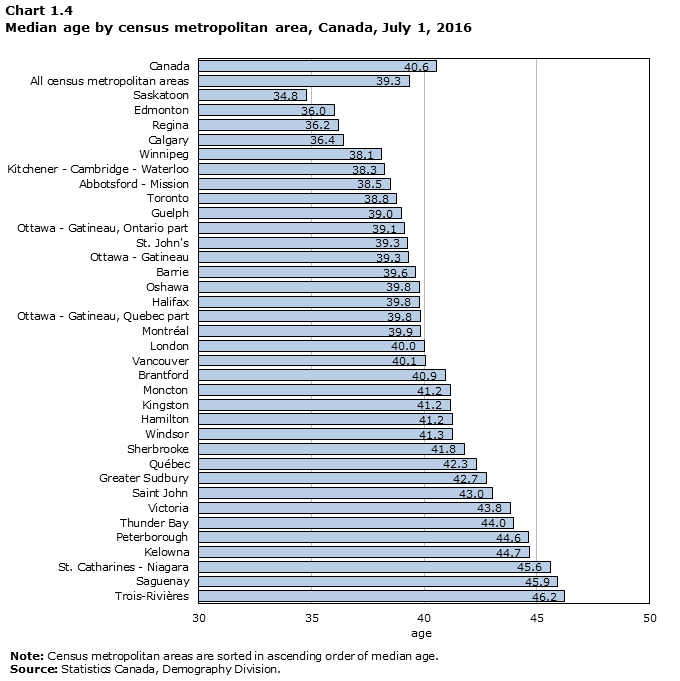
Data table for Chart 1.4
| Census metropolitan areas | Age |
|---|---|
| Trois-Rivières | 46.2 |
| Saguenay | 45.9 |
| St. Catharines - Niagara | 45.6 |
| Kelowna | 44.7 |
| Peterborough | 44.6 |
| Thunder Bay | 44.0 |
| Victoria | 43.8 |
| Saint John | 43.0 |
| Greater Sudbury | 42.7 |
| Québec | 42.3 |
| Sherbrooke | 41.8 |
| Windsor | 41.3 |
| Hamilton | 41.2 |
| Kingston | 41.2 |
| Moncton | 41.2 |
| Brantford | 40.9 |
| Vancouver | 40.1 |
| London | 40.0 |
| Montréal | 39.9 |
| Ottawa - Gatineau, Quebec part | 39.8 |
| Halifax | 39.8 |
| Oshawa | 39.8 |
| Barrie | 39.6 |
| Ottawa - Gatineau | 39.3 |
| St. John's | 39.3 |
| Ottawa - Gatineau, Ontario part | 39.1 |
| Guelph | 39.0 |
| Toronto | 38.8 |
| Abbotsford - Mission | 38.5 |
| Kitchener - Cambridge - Waterloo | 38.3 |
| Winnipeg | 38.1 |
| Calgary | 36.4 |
| Regina | 36.2 |
| Edmonton | 36.0 |
| Saskatoon | 34.8 |
| All census metropolitan areas | 39.3 |
| Canada | 40.6 |
|
Note: Census metropolitan areas are sorted in ascending order of median age. Source: Statistics Canada, Demography Division. |
|
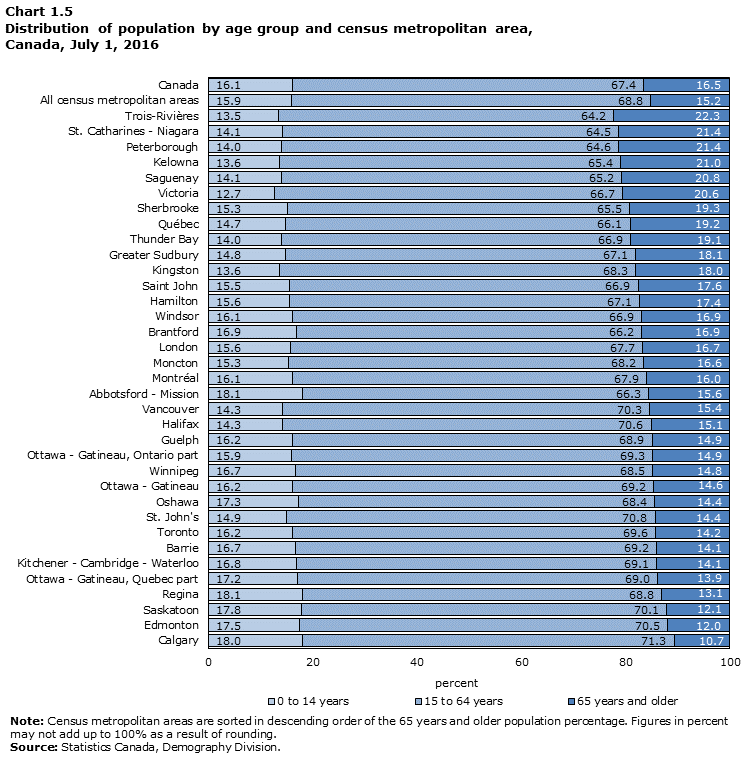
Data table for Chart 1.5
| Census metropolitan areas | 0 to 14 years | 15 to 64 years | 65 years and older |
|---|---|---|---|
| percent | |||
| Calgary | 18.0 | 71.3 | 10.7 |
| Edmonton | 17.5 | 70.5 | 12.0 |
| Saskatoon | 17.8 | 70.1 | 12.1 |
| Regina | 18.1 | 68.8 | 13.1 |
| Ottawa - Gatineau, Quebec part | 17.2 | 69.0 | 13.9 |
| Kitchener - Cambridge - Waterloo | 16.8 | 69.1 | 14.1 |
| Barrie | 16.7 | 69.2 | 14.1 |
| Toronto | 16.2 | 69.6 | 14.2 |
| St. John's | 14.9 | 70.8 | 14.4 |
| Oshawa | 17.3 | 68.4 | 14.4 |
| Ottawa - Gatineau | 16.2 | 69.2 | 14.6 |
| Winnipeg | 16.7 | 68.5 | 14.8 |
| Ottawa - Gatineau, Ontario part | 15.9 | 69.3 | 14.9 |
| Guelph | 16.2 | 68.9 | 14.9 |
| Halifax | 14.3 | 70.6 | 15.1 |
| Vancouver | 14.3 | 70.3 | 15.4 |
| Abbotsford - Mission | 18.1 | 66.3 | 15.6 |
| Montréal | 16.1 | 67.9 | 16.0 |
| Moncton | 15.3 | 68.2 | 16.6 |
| London | 15.6 | 67.7 | 16.7 |
| Brantford | 16.9 | 66.2 | 16.9 |
| Windsor | 16.1 | 66.9 | 16.9 |
| Hamilton | 15.6 | 67.1 | 17.4 |
| Saint John | 15.5 | 66.9 | 17.6 |
| Kingston | 13.6 | 68.3 | 18.0 |
| Greater Sudbury | 14.8 | 67.1 | 18.1 |
| Thunder Bay | 14.0 | 66.9 | 19.1 |
| Québec | 14.7 | 66.1 | 19.2 |
| Sherbrooke | 15.3 | 65.5 | 19.3 |
| Victoria | 12.7 | 66.7 | 20.6 |
| Saguenay | 14.1 | 65.2 | 20.8 |
| Kelowna | 13.6 | 65.4 | 21.0 |
| Peterborough | 14.0 | 64.6 | 21.4 |
| St. Catharines - Niagara | 14.1 | 64.5 | 21.4 |
| Trois-Rivières | 13.5 | 64.2 | 22.3 |
| All census metropolitan areas | 15.9 | 68.8 | 15.2 |
| Canada | 16.1 | 67.4 | 16.5 |
|
Note: Census metropolitan areas are sorted in descending order of the 65 years and older population percentage. Figures in percent may not add up to 100% as a result of rounding. Source: Statistics Canada, Demography Division. |
|||
Trois-Rivières CMA has the oldest population
With respect to median age, on July 1, 2016, the oldest population was in the Trois-Rivières CMA (46.2 years), followed by the Saguenay CMA (45.9 years) and the St. Catharines–Niagara CMA (45.6 years).
The Trois-Rivières CMA (22.3%) also had the largest share of persons aged 65 years and older among all the CMAs. The St. Catharines–Niagara CMA and Peterborough CMA had the second highest proportion of persons aged 65 years and older, at 21.4% each.
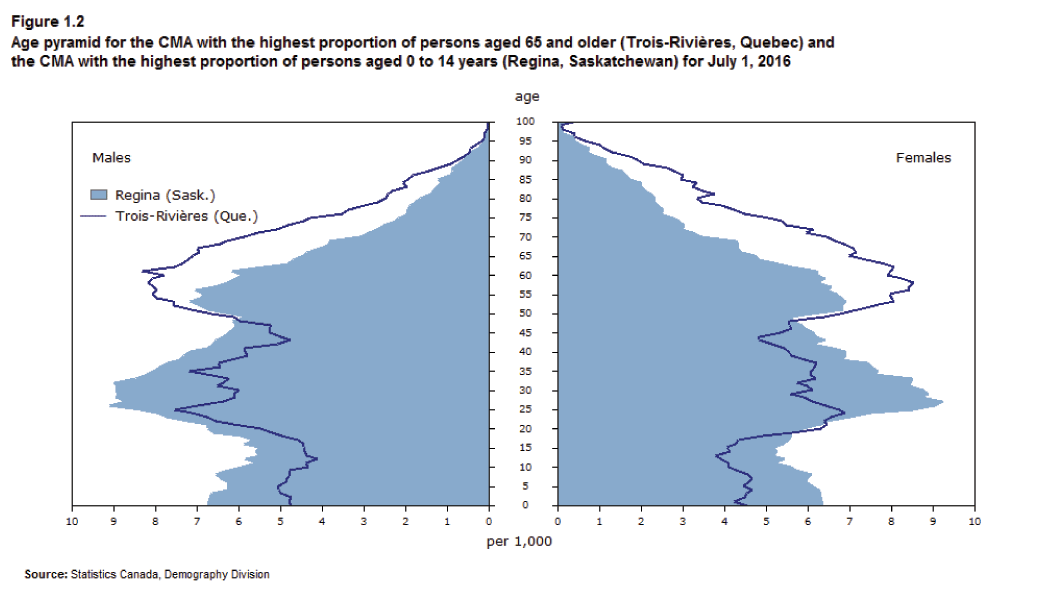
Data table for Figure 1.2
This stacked column graph or age pyramid compares the age structure of the CMA of Trois-Rivières (Quebec) and the CMA of Regina (Saskatchewan) for July 1, 2016 in relative value.
The left side shows males and the right side shows females.
The horizontal axis shows the population in relative value and the vertical axis shows age.
| Age | Regina (Sask.) | Trois-Rivières (Que.) | ||
|---|---|---|---|---|
| Males | Females | Males | Females | |
| per thousand | ||||
| 0 | 6.7 | 6.4 | 4.7 | 4.5 |
| 1 | 6.7 | 6.3 | 4.8 | 4.2 |
| 2 | 6.7 | 6.3 | 4.7 | 4.5 |
| 3 | 6.6 | 6.3 | 5.0 | 4.5 |
| 4 | 6.3 | 6.3 | 5.0 | 4.7 |
| 5 | 6.2 | 6.1 | 5.0 | 4.5 |
| 6 | 6.3 | 6.0 | 4.9 | 4.6 |
| 7 | 6.4 | 6.0 | 4.8 | 4.7 |
| 8 | 6.5 | 6.1 | 4.8 | 4.6 |
| 9 | 6.2 | 5.7 | 4.8 | 4.3 |
| 10 | 5.9 | 5.6 | 4.3 | 4.1 |
| 11 | 5.6 | 5.2 | 4.4 | 4.1 |
| 12 | 5.8 | 5.4 | 4.1 | 3.9 |
| 13 | 5.5 | 5.2 | 4.4 | 3.8 |
| 14 | 5.6 | 5.3 | 4.4 | 4.1 |
| 15 | 5.5 | 5.2 | 4.4 | 4.1 |
| 16 | 5.9 | 5.4 | 4.4 | 4.3 |
| 17 | 5.6 | 5.5 | 4.6 | 4.3 |
| 18 | 5.9 | 5.6 | 5.0 | 4.9 |
| 19 | 6.6 | 5.6 | 5.2 | 5.6 |
| 20 | 6.7 | 5.9 | 5.5 | 6.3 |
| 21 | 6.7 | 6.3 | 6.1 | 6.5 |
| 22 | 7.2 | 6.5 | 6.5 | 6.4 |
| 23 | 7.7 | 7.0 | 6.8 | 6.6 |
| 24 | 8.0 | 7.5 | 7.1 | 6.9 |
| 25 | 8.3 | 8.5 | 7.5 | 6.8 |
| 26 | 9.1 | 9.0 | 7.0 | 6.4 |
| 27 | 8.7 | 9.2 | 6.4 | 6.1 |
| 28 | 8.9 | 8.7 | 6.1 | 5.9 |
| 29 | 8.9 | 8.9 | 6.1 | 5.6 |
| 30 | 8.9 | 8.8 | 6.0 | 6.1 |
| 31 | 8.9 | 8.4 | 6.5 | 6.0 |
| 32 | 9.0 | 8.5 | 6.4 | 5.7 |
| 33 | 8.5 | 8.5 | 6.2 | 6.2 |
| 34 | 8.2 | 7.6 | 6.8 | 6.1 |
| 35 | 8.0 | 7.7 | 7.2 | 6.1 |
| 36 | 7.9 | 7.5 | 6.4 | 6.2 |
| 37 | 7.7 | 7.4 | 6.5 | 6.2 |
| 38 | 7.4 | 6.8 | 6.2 | 5.9 |
| 39 | 7.3 | 6.9 | 5.8 | 5.6 |
| 40 | 7.2 | 6.9 | 5.8 | 5.5 |
| 41 | 6.7 | 6.6 | 5.9 | 5.4 |
| 42 | 6.6 | 6.1 | 5.1 | 5.1 |
| 43 | 6.5 | 6.4 | 4.8 | 4.8 |
| 44 | 6.4 | 6.2 | 5.0 | 4.8 |
| 45 | 6.2 | 6.1 | 5.2 | 5.3 |
| 46 | 6.1 | 5.9 | 5.3 | 5.6 |
| 47 | 6.1 | 5.9 | 5.2 | 5.6 |
| 48 | 6.1 | 5.6 | 6.0 | 5.6 |
| 49 | 5.8 | 5.6 | 6.1 | 6.4 |
| 50 | 6.2 | 6.1 | 6.6 | 6.8 |
| 51 | 6.7 | 6.8 | 7.1 | 7.2 |
| 52 | 6.9 | 6.8 | 7.5 | 7.6 |
| 53 | 7.2 | 6.9 | 7.6 | 8.1 |
| 54 | 6.9 | 6.8 | 8.0 | 8.0 |
| 55 | 6.8 | 6.7 | 8.1 | 8.0 |
| 56 | 7.0 | 6.5 | 8.0 | 8.4 |
| 57 | 6.6 | 6.6 | 8.0 | 8.4 |
| 58 | 6.3 | 6.2 | 8.2 | 8.5 |
| 59 | 6.1 | 6.4 | 8.1 | 8.3 |
| 60 | 5.9 | 6.2 | 7.8 | 7.9 |
| 61 | 6.2 | 6.2 | 8.3 | 8.0 |
| 62 | 5.4 | 5.6 | 7.5 | 8.1 |
| 63 | 4.8 | 5.3 | 7.4 | 7.9 |
| 64 | 4.7 | 4.8 | 7.2 | 7.4 |
| 65 | 4.4 | 4.7 | 7.1 | 7.0 |
| 66 | 4.4 | 4.4 | 6.9 | 7.2 |
| 67 | 4.0 | 4.3 | 7.0 | 7.1 |
| 68 | 3.8 | 4.3 | 6.4 | 6.9 |
| 69 | 3.8 | 4.3 | 6.3 | 6.7 |
| 70 | 3.1 | 3.5 | 5.9 | 6.5 |
| 71 | 2.9 | 3.2 | 5.5 | 6.0 |
| 72 | 2.7 | 3.0 | 5.1 | 6.1 |
| 73 | 2.5 | 3.0 | 4.8 | 5.5 |
| 74 | 2.2 | 2.9 | 4.4 | 5.4 |
| 75 | 2.2 | 2.8 | 4.3 | 5.1 |
| 76 | 1.9 | 2.5 | 3.5 | 4.5 |
| 77 | 1.9 | 2.5 | 3.4 | 4.2 |
| 78 | 1.9 | 2.4 | 3.0 | 3.9 |
| 79 | 1.8 | 2.3 | 2.7 | 3.5 |
| 80 | 1.6 | 2.3 | 2.5 | 3.3 |
| 81 | 1.4 | 2.2 | 2.4 | 3.8 |
| 82 | 1.3 | 2.1 | 2.3 | 3.5 |
| 83 | 1.2 | 2.0 | 2.0 | 3.2 |
| 84 | 1.1 | 2.0 | 2.1 | 3.3 |
| 85 | 1.2 | 1.7 | 1.9 | 3.0 |
| 86 | 0.9 | 1.6 | 1.8 | 3.0 |
| 87 | 0.9 | 1.5 | 1.4 | 2.8 |
| 88 | 0.9 | 1.3 | 1.2 | 2.6 |
| 89 | 0.7 | 1.2 | 0.9 | 2.1 |
| 90 | 0.6 | 1.2 | 0.7 | 1.9 |
| 91 | 0.5 | 0.9 | 0.6 | 1.7 |
| 92 | 0.4 | 0.7 | 0.5 | 1.3 |
| 93 | 0.2 | 0.8 | 0.4 | 1.1 |
| 94 | 0.2 | 0.6 | 0.3 | 1.0 |
| 95 | 0.1 | 0.4 | 0.2 | 0.7 |
| 96 | 0.1 | 0.4 | 0.1 | 0.4 |
| 97 | 0.1 | 0.1 | 0.1 | 0.4 |
| 98 | 0.0 | 0.1 | 0.0 | 0.1 |
| 99 | 0.0 | 0.1 | 0.0 | 0.1 |
| 100 and over | 0.0 | 0.2 | 0.0 | 0.4 |
| Source: Statistics Canada, Demography Division. | ||||
Figure 1.2 compares the age pyramid for the Regina CMA, where the share of youth aged 0 to 14 years was the largest, with the pyramid for Trois-Rivières, which had the highest proportion of persons aged 65 years and older. The top of the pyramid, which is wider for Trois-Rivières than for Regina, indicates that the age structure is older in the Quebec CMA. As well, the wider base of the Regina CMA pyramid indicates that children account for a larger share of the population in this CMA. The relatively large size of this age group is in part due to a high birth rate—the third highest for a CMA—and zero internal net migration among children aged 0 à 14 years, as opposed to negative internal net migration for the other age groups.
Fastest aging CMAs in Quebec and Ontario
Even though the populations of CMAs are younger than in the rest of Canada, these populations are also aging. The median age of the population of CMAs increased 1.4 years between July 1, 2006, and July 1, 2016. As well, the proportion of persons aged 65 years and older rose from 12.4% to 15.2% during the same period, an increase of 2.8 percentage points.
An increase in the median age combined with an increase in the proportion of persons aged 65 and older was observed in almost all of Canada’s CMAs. The biggest increases in the proportion of persons aged 65 years and older between 2006 and 2016 were recorded in Quebec CMAs, specifically Saguenay (+6.0 percentage points), Trois-Rivières (+5.8 percentage points), and Sherbrooke and Québec (+5.2 percentage points each). In addition, the largest increases in median age over the past decade were in the Ontario CMAs of St. Catharines–Niagara and Windsor (+4.1 years in each case).
Lastly, the five Prairie CMAs stood out on account of their slower population aging than in the rest of Canada. In each of these CMAs, the increase in the proportion of the population aged 65 years between 2006 and 2016 did not exceed +1.7 percentage points (compared with +3.3 percentage points for Canada) and the change in median age over the same period was +1.1 years at most (compared with +1.7 years for Canada).
Notes
- Date modified:
